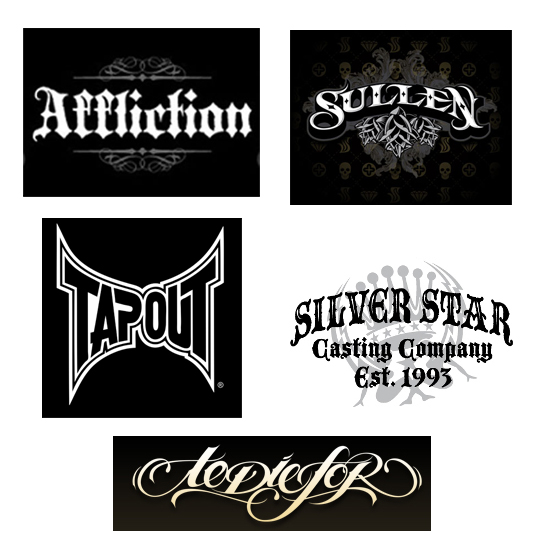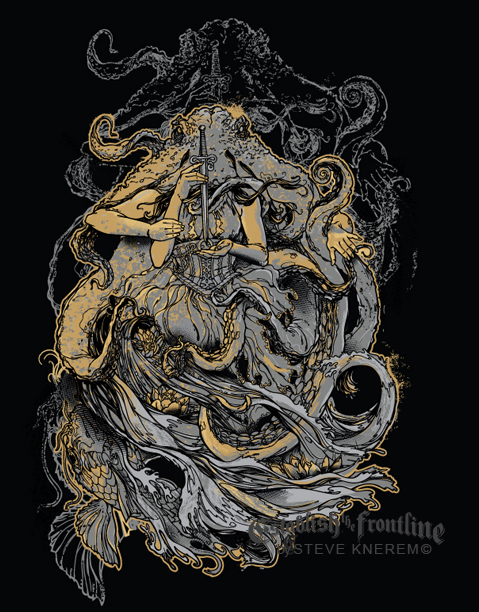Blog
Starting your own shirt line. PART I: Start – Up

Greetings friends,
This is Steve Knerem and I’m a freelance illustrator from Cleveland, Ohio that specializes in hand drawn art used for apparel and editorial pieces. You can view my work at www.steveknerem.com.
When asked by Go Media to write some tutorials about work I’ve done, I was more than excited to help others who are in the process of starting their own shirt line. Turns out there was too much to say in just one article, so I’ve split it into a three part series titled “Starting a Shirt Line.”
- PART I – Start – Up
- PART II – The creation of your art and working with a printer
- PART III – Business
Let’s boogie!
So you’re a great illustrator, designer and master of artistic mayhem. You rule the design world and celebrities are begging for your next shirt design, right? This is your dream, everyone loves your dream, right? Well, let’s figure out how to make your dream a reality, make the celebrities beg for your next piece, and of course, make you a big ‘ol wad of cash at the end of the day.
In the Spring of 2009 I was asking myself the questions “How do I start a shirt line?” and “Where do I begin?”. In this article I will share 3 points that will help you get started: Creating your idea, Research, and Who is Interested?
CREATING YOUR IDEA
Simply put, what do you like? Skulls, ponies, vampire movies? The answer to this question will be the factor that separates you from the competition. Not necessarily that you draw the best looking ponies with brass knuckles, but originality. What other questions should you ask yourself?
How about: do you design in Photoshop? Are you a vector wizard in Illustrator? Do you hand draw your art?
What about subject matter? Do you dive into pentagrams, do you draw tattoo esq illustrations, or something else? After you answer these few questions you’re on the move.
Here is one of my shirt illustrations. This is one of the first drawings in a sketchbook solely dedicated to my shirt line. I had to ask myself what I like, because after doing work for clients and their content I needed to think about me and what I would like to see on a shirt. For me it’s art nouveau line art. I love following tattoo artists and seeing what they create. I also love to draw the human figure. Remember, keep it simple and have fun! I’ll thoroughly dissect the drawing in PART II, but for now here is the “The Octolady.” The first image is the sketch, and the second is the final piece.
I didn’t overwhelm myself with “questions of worry” such as “What will people think” or “Is it good enough?”. I approached this piece, as I do with all my work, with the more strategic question “How do I set my work apart from the competition?” My answers have been “It’s original and I’m not trying to copy or follow any specific style or look.”
I have also educated myself with print locations on a shirt (covered in PART II). I shopped developed ideas from my sketchbook around to friends and clothing stores to get some feedback as well. This might seem like overkill, but the results of such effort lead into the next point, RESEARCH.
RESEARCH
Research is a large part before starting a successful line. Let’s be honest people. You have to know how to get your target audience to buy your shirts. Let’s start looking at successful brands out there: AFFLICTION, TAPOUT, ECKO, SILVER STAR, SULLEN, TO DIE FOR, and the list goes on.

Find out the success stories of these brands and where it all started for them. I found out I wasn’t that much different; I’m just a dude with some creative ideas that wants to provide a good product.

Start researching the market of a successful apparel brand. For example, TAPOUT struck gold with the rising sport of MMA. The point is, TAPOUT knows it’s target market, they’re not trying to hit every person from the soccer mom to the war vet. Likewise, you need to find out how and where to sell. Would you sell on-line and/or in stores?
Grab a computer and obliterate Google with your questions, it’s free! Some great sites I use are T- Shirt Forums and I am the trend. These are great resources where I probably learned 50% of my information just by reading what people were asking. They cover business, printing, start-up costs and everything in between.
HOMEWORK: Take 15 minutes everyday for 2 weeks and research these sites, find other sites and follow the successful brands on Facebook and Twitter. You’ll take yourself to school and not have to pay a dime. It’s worth the investment.
Ok, we covered who to research (TAPOUT, Silver Star, etc.) and where to research (Google, Blogs, etc). What else? Oh yeah, business research. I’ll detail more in the PART III, but for now, here are some points.
Take into consideration that everybody has different backgrounds. Personally I needed to learn and keep learning about running a business. Start with SCORE.org. This is a nationwide company that offers FREE advice, FREE counseling, FREE paperwork and FREE information. Familiarize yourself with becoming a business person. YES YOU THE GENIUS ARTIST; find out the paper work you need and what it will take to run a well structured shirt business. I spent the winter months of 2009-2010 devouring the info on the SCORE website and about 50 more websites. I feel a hell of a lot more educated after all this legwork.
My overall point with research is that it doesn’t cost you any money before you have to spend money. When you know what, where, and how much money to spend you will have an educated decision that will only help you in the long run. Let’s keep moving.
WHO IS INTERESTED?
I figured everyone would like my work and want to buy my product. Then I got a reality check. After friends and family buy, who else is interested? A good rule of thumb is knowing your target market, who is going to be most interested, and who are you going to attract to buy your awesome shirts.

To find my answer I showed my developed sketchbook work and final designs to tattoo artists, boutique stores (not baby clothing stores but higher end fashion), skate and snow stores, other artists in film, gaming and comics. Do you see the pattern? These groups are my target audience. These specific people I know will be attracted to my work and say “Hell yes I’ll buy one!” (That is an actual quote.) It’s not necessarily ages 14 -25 but a group of people who appreciate my style. I can shop my work around to many places and people and not handcuff myself with a certain age group. The funniest thing to this day is I have moms buying Establish the Frontline shirts for their sons without hesitation. WHAT!? That was another surprise niche.
Lastly, here’s the truth: not everyone will like your work, not everyone will buy your shirts. Start developing tough skin. You’re a salesperson now and you are going to meet thousands of people with mixed reactions. Be excited when someone buys and don’t be a poor sport or unprofessional when someone doesn’t; it’s business, not personal.
WRAP UP
To recap the START-UP article we covered:
CREATING YOUR IDEA – originality, what do you like and how will you set yourself apart from the competition.
RESEARCH – researching successful brands, blogs and t-shirts forums, score.org on how to run a shirt business.
WHO IS INTERESTED? – find your niche market, know who to sell to and who will buy.

I hope this article helps you get started and answers some of your questions. The night before I finished writing this article I was thinking about my past year and half and what has helped me get to where I’m at. Rome wasn’t built in a day. Everything takes time, everything is still taking time. Be patient, strive for quality not quantity. Being patient is frustrating. Personally I want results immediately, even though I realize the less I rush the better the outcome will be.
Next up is the fun part, “The creation of your art and working with a printer”, I can hardly wait!
READ PART 2 HERE!
BIO: The work of Steve Knerem features bold line art and digital paint used to portray imaginative creatures, the human figure and ornate objects. Steve’s work is most notably used for apparel and editorial art that combine a realistic and decorative style.

